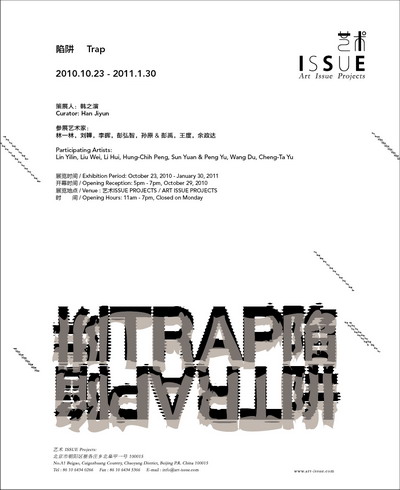
策 展 人:韩之演
参展艺术家:王度、林一林、孙原 & 彭禹、彭弘智、刘韡、李晖、余政达
展览时间:2010年10月23日 – 2011年1月30日
开幕时间:2010年10月29日下午5点 – 7点
展览地点:艺术ISSUE PROJECTS
北京市朝阳区崔各庄乡北皋甲1号 100015
开放时间:上午11点 – 下午7点,周一休息
陷阱,比喻使人受骗上当的圈套。它通过种种伪装,使人不能洞悉真相,堕入其中,被对方所控。《汉书•食货志下》中记到:“夫县法以诱民,使入陷阱。”清朝戴名世在《盲者说》中:“倀倀焉躓且蹶而不之悟,卒蹈於网罗入於陷阱者,往往而是。”
与“陷阱”近义的词“枷锁”或者“桎梏”,是我们极其熟悉、被我们当做精神敌人的物质化对象。枷锁与陷阱的不同在于枷锁的有形与陷阱的无形,沉甸甸的木枷或铁链,明确地表明着自己的身份,人们可以用铁锤用火焰去击碎它们或熔毁它们,使人获得“解放”。但是陷阱却不然,天下没有任何一个陷阱上明确地写着“陷阱”两字,它在最不可能出现的地方出现,在你认为最安全的时候制造杀机,在你最为熟悉的一条坦途上使你陷落。它像经过了千百种抗生素的锤炼,而成为了一种不断在升级、不断在繁殖的超级细菌,时刻潜伏在我们身边。它是“人性”的,它洞悉着人性的缺陷,寻找着破绽;它是智慧的,可以随着认知的提高而随时幻化着自己的形状。最可怕的还在于它的无形与侵蚀,让你在不知不觉中坠落,或在你小心谨慎的认为躲避开一次陷落的时候,却用摸索的双手为自己挖下一个陷阱。
我们的身边,正是充满了这样的陷阱:安定美好的和谐社会在挥舞着它的大旗;虚假的经济繁荣制造了满足感,泡沫般填满了我们脚下的每一寸土地,让我们陷落;永远为了某些目的而服务的面目亲善的大众媒体;精神沉迷于体表的表层满足感时,精神被腐蚀;虚伪笑容背后的居心叵测……。所有的这些陷阱::社会的、文化的、经济的、语言的、媒体的、人性的,防不胜防。让我们在不经意间,毫无反抗的准备与能力时落入其中,被其所控。正如《礼记•中庸》中所记:“人皆曰予知,驱而纳诸罟擭陷阱之中,而莫之知辟也。”
参展的艺术家王度、林一林、孙原 & 彭禹、彭弘智、刘韡、李晖、余政达正是用他们自己的方式:或是直接表现坠入陷阱的无奈;或是用类似玩笑的行为来消解;或是探讨文化语言产生的陷阱;或是用反讽的方式,用美好的语言编织陷阱,或制造出视觉的灿烂与美好,麻痹观众的心神。他们或批判、或嘲讽、或玩笑、或游戏、或消解,但无不在提醒你:我们已经身处不同的陷阱边缘,抑或早已坠入各种陷阱里面,但我们中的大多数人,毫不自知。
Trap
Curator: Han Jiyun
Participating Artists: Wang Du, Lin Yilin, Sun Yuan & Peng Yu, Hung-Chih Peng, Liu Wei, Li Hui, Cheng-Ta Yu
Exhibition Period: October 23, 2010 – January 30, 2011
Opening Reception: 5pm - 7pm, October 29, 2010
Venue: ART ISSUE PROJECTS
No.A1 Beigao, Cuigezhuang County, Chaoyang District, Beijing 100015
Opening Hours: 11am - 7pm, Closed on Monday
Tel: 86 10 6434 0266
Fax: 86 10 6434 5366
E-mail: info@art-issue.com
A trap is a metaphor for people who have been ensnared by trickery. Adopting various disguises, it renders one unable to clearly understand the reality of the situation, and our adversary has complete control as we sink further into the trap. The Han History of Food and Commodities records: “county law leads the people, causing them to fall into its trap.” In the Qing dynasty Blind Man Says, Dai Mingshi stated: “But all too often, one aimlessly stumbles, nearly unconscious and suddenly steps into the net of the trapper.”
We are quite familiar with words that approach “trap” in meaning, such as “chains” or “shackles”, which we view as the material object of our spiritual enemy. The difference between the two lies in the fac that chains are visible, while traps are invisible. A heavy wooden yoke or iron chains, clearly reveal their identity and can be smashed with a hammer or melted down with flames to achieve “liberatation”. Traps, however, are entirely different. A trap has never existed upon which the word “trap” was clearly written for all to see. Traps appear where and when we least expect them, going in for the kill when we believe we are at our safest, falling victim on the turf with which we are most familiar. It is like, as if tempered by hundreds upon thousands of antibiotics, an endlessly spreading and reproducing super germ was incubating by our side. Traps are “human nature”, the flaw in the clear understanding of human nature, the sought-after weakspot; the trap is intellegence, following increased cognitive abilities and magically transforming at any moment. What’s most terrifyig is its intangiablity and corrosive quality, leading you to sink deeper and deeper in entirely unconciously, or when thinking you have carefully avoided a trap, fumbling around with two hands and inadvertantly digging yourself a new trap.
We are surrounded by precisely these sorts of trap: While the flag of stable and glorious harmonious society is held high, false economic prosperity creates a sense of contentment; the land beneath our feet is like a bubble, capable of bursting at any moment and leaving us tumbling downward; the mass-media puts on a the appearance of good-will but only truly serves for its own objectives. When our spirits indulge in the surface level satisfaction of the body, they become corrupted; true intentions are hidden behind hypocritical smiles…
All these sorts of traps: societal, cultural, economic, linguistic, informational, all human nature and impossible to fend off. When we are inattentive, entirely without preparation or ability to resist, we fall under its control. Just as is recorded in the Golden Mean from the Book of Rites, "People all believe themselves to be quite clever, but once driven to a trap, they don't know how to avoid."
The participating artists, Wang Du, Lin Yilin, Sun Yuan & Peng Yu, Hung-Chih Peng, Liu Wei, Li Hui, and Cheng-Ta Yu, each use their own methods to comment upon the trap: directly displaying the unavoidability of failing into it; using irony and jesting behavior dispel it; exploring the cultural language which produces it; or manufacturing visual splendor and beauty to numb the viewer’s mind. Whether they are criticizing, sneering, joking, playing or banishing, not one goes without alerting us: we are all personally on the brink of one trap or another, and could it be that we’ve already fallen in but the majority of us are entirely unaware of it?
艺术家作品
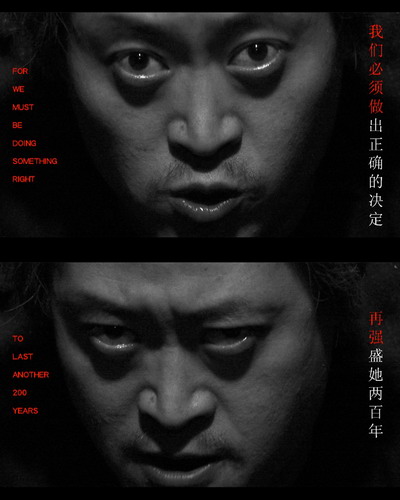
彭弘智_两百年_HD 单频道录像_4分04秒_Hung-Chih Peng_200 Years_single Channel HD Videos_2008
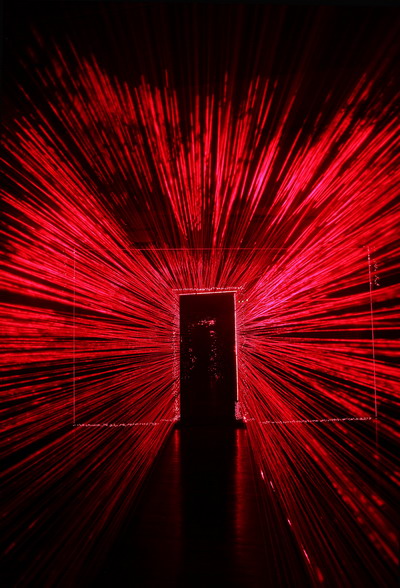
李晖_门之二_激光 镜子 木头_尺寸可变_Li Hui_The Door 2_laser mirror wood_dimension variable_2009
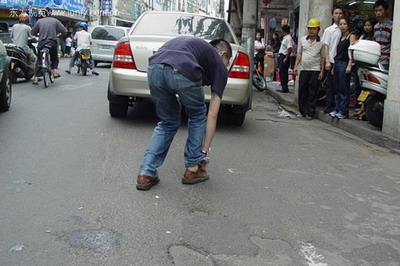
林一林_凯旋_行为录像_90分钟_ Lin Yilin_Triumph_performance video_90 mins_2009
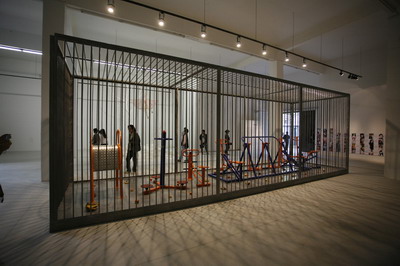
刘韡_一种生活方式_装置_A Life Style_9MX3MX3M_Installation_2007
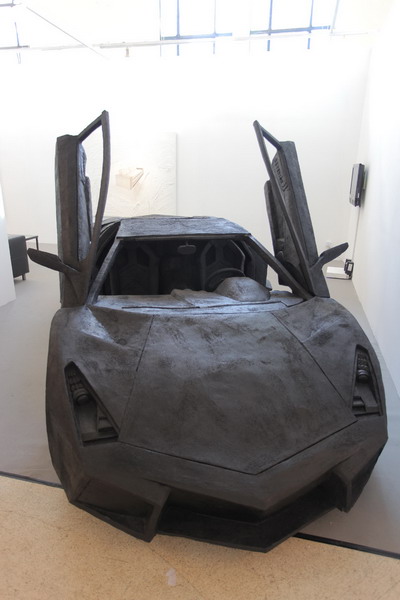
彭弘智_两百年_HD 单频道录像_4分04秒_Hung-Chih Peng_200 Years_single Channel HD Videos_2008

孙原&彭禹_今夜我不睡_行为录像_Sun Yuan&Peng Yu_I do not sleep tonight_performance video_2010
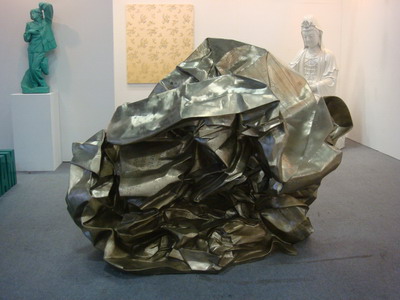
王度_中国日报_白铜_Wang Du_Chai Daily-2006-2007Directory of inrestment in china-250X130X156-white brass_2006-2007

余郑达_附身【声】者 介绍_HDV 影像装置 彩色 有声_Cheng Ta Yu_Ventriloquists Introduction_HDV video installation color sound_2008

